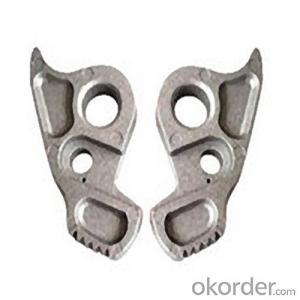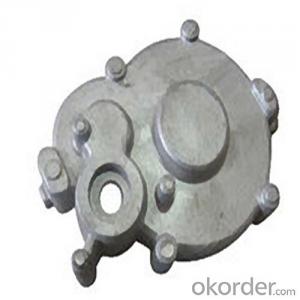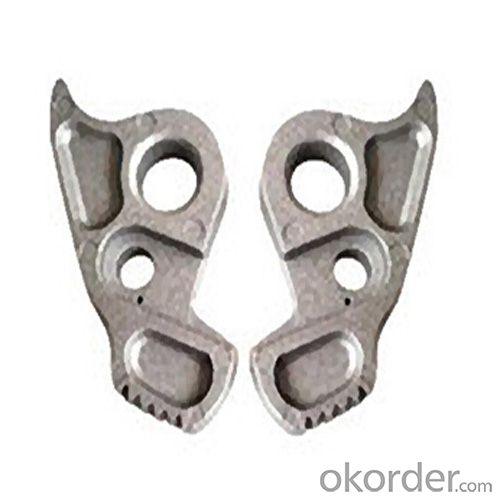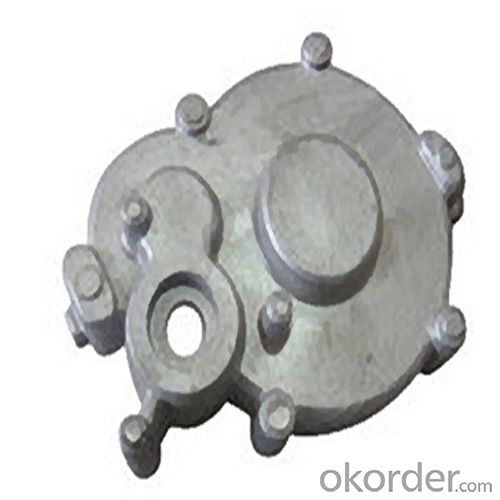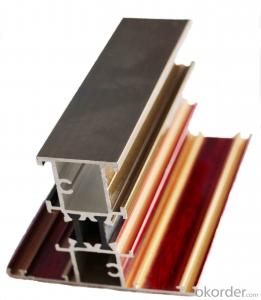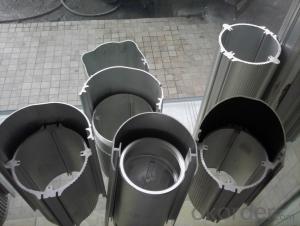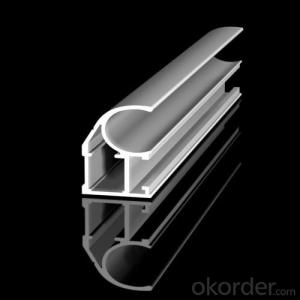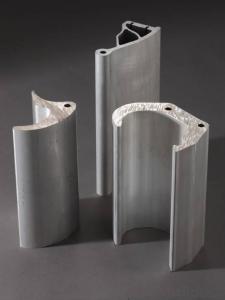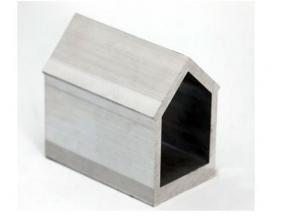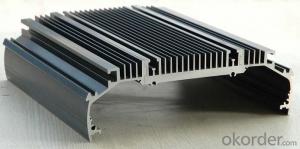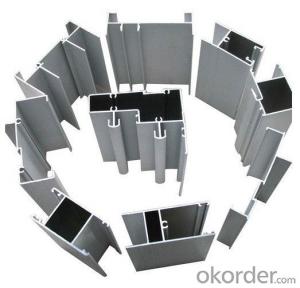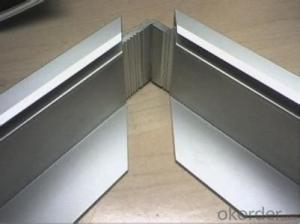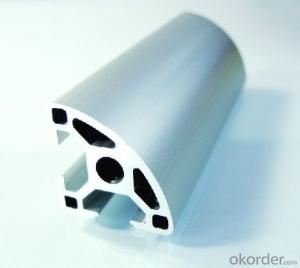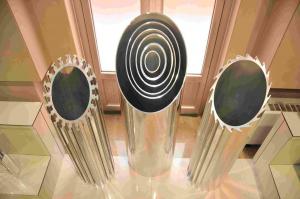Aluminum Extrusion Profiles Malaysia - Mold Metal Casting with High Quality and Best Price
- Loading Port:
- Guangzhou
- Payment Terms:
- TT OR LC
- Min Order Qty:
- 1000 pc
- Supply Capability:
- 100000 pc/month
OKorder Service Pledge
OKorder Financial Service
You Might Also Like
1. Structure of Mold Metal Casting Description:
The casting equipment and the metal dies represent large capital costs and this tends to limit the process to high volume production. Manufacture of parts using die casting is relatively simple, involving only four main steps, which keeps the incremental cost per item low. It is especially suited for a large quantity of small to medium-sized castings, which is why die casting produces more castings than any other casting process.[1] Die castings are characterized by a very good surface finish (by casting standards) and dimensional consistency.Two variants are pore-free die casting, which is used to eliminate gas porosity defects; and direct injection die casting, which is used with zinc castings to reduce scrap and increase yield.
2.Main Features of the Mold Metal Casting:
Die Casting
High Precison&Tolerance
Motor vehicle
External processing
3. Mold Metal Casting Images
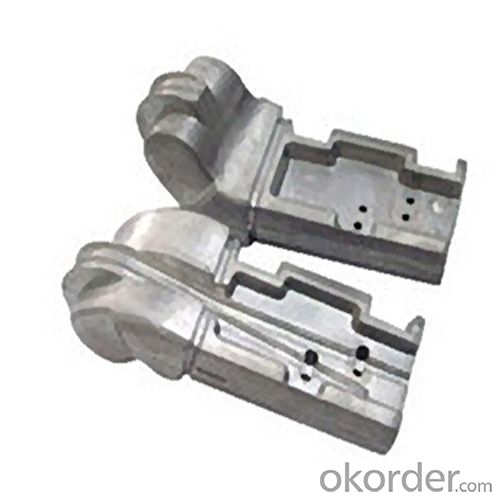
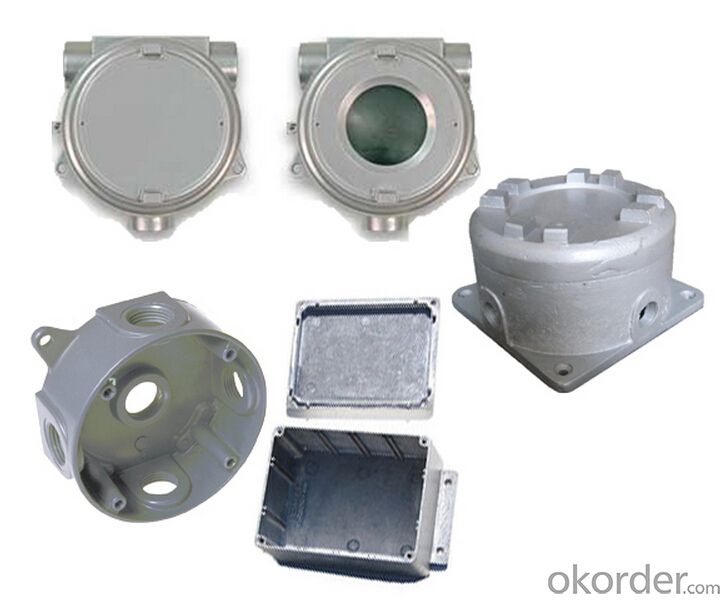
4. Mold Metal Casting Specification
| Material | aluminum alloy A380,A360.ADC12,Zinc alloy 3#zinc,5#zinc and 7#zinc,etc |
| Designs | 1.As per the customer’s drawings 2.As per the customer’s samples |
| Surface treatment | 1.sand blasting, 2.power coating 3.painting 4.anodization 5.electrophoresis 6.zinc plating 7.black oxidation. |
| Software | Pro/E, Auto CAD, CAXA UG, CAD/CAM/CAE |
| Certificate | ISO9001:2008, ROHS,SGS |
| Service | OEM service available |
| Products | All kinds of aluminum &zinc alloy casting: include automotive parts, railroad parts, medical parts, marine parts, lighting parts, pump body, valve parts, architectural parts and furniture parts so on |
| Advantage | 1.With 8 years in Aluminum & zinc alloy casting; 2.Near shanghai Port and Air Port; 4.Passed ISO9001:2008/Rosh/SGS 5.From Casting to Finished surface, Owned casting, polishing and plating workshops, We can offer Good quality and strict delivery time. 6.With samples and order: We can offer dimension report,Chemical composition and Mechanical properties |
5.FAQ
Q. What is Die Casting? How is it different from other "casting" process?
"Die casting is the process of forcing molten metal under high pressure into mold cavities (which are machined into dies). Most die castings are made from non-ferrous metals." It's known as "pressure die casting" in Europe. "Gravity casting" (a.k.a. "permanent mold casting" in USA and Canada) uses gravity to fill the mold.
Q. I don't have experience designing parts for make mold metal casting , and want to bring existing machined parts to die casting. What should I know?
We have a professional person to help you.
- Q: 120 and 150 hidden frame glass curtain wall aluminum profile per square meter dosage, there may be curtain wall quotation cost analysis table
- Aluminum curtain wall is about 8-10kg/ square meters.I don't have any formAt present, the price of aluminum profile is 20-30 yuan /kg (anodizing, powder spraying, fluorocarbon spraying and other surface treatment)A window sash is glass, aluminum, metal fittings, glue, these things, aluminum, glass is accounted for the bulk
- Q: What are the thermal properties of aluminum profiles?
- Due to its inherent characteristics as a metal, aluminum profiles possess favorable thermal properties. With its high thermal conductivity, aluminum can efficiently transfer heat, making it an ideal choice for applications requiring heat dissipation or thermal management. Furthermore, aluminum profiles exhibit minimal expansion and contraction with temperature changes due to their low coefficient of thermal expansion. This exceptional stability and resistance to warping or distortion, even in extreme temperature variations, make aluminum profiles highly reliable. In addition, aluminum profiles have a comparatively low melting point, making them suitable for applications involving high operating temperatures. The ability of aluminum to withstand such temperatures without compromising its structural integrity further enhances its thermal properties. Moreover, aluminum profiles demonstrate excellent thermal insulation properties as they are not easily conductive of heat. This makes them a suitable choice for applications requiring thermal insulation or the prevention of heat transfer, such as in building and construction or HVAC systems. In summary, the thermal properties of aluminum profiles, including high thermal conductivity, low coefficient of thermal expansion, high melting point, and good thermal insulation, contribute to their versatility and widespread use across various industries, ranging from automotive and aerospace to electronics and construction.
- Q: Is it possible to utilize aluminum profiles in the construction of carports or garages?
- <p>Yes, aluminum profiles can be used for carports or garages. They are known for their durability, corrosion resistance, and lightweight properties, making them ideal for such structures. Aluminum profiles are also easy to install and maintain, and they can withstand various weather conditions without rusting. This material is commonly used for the framing and support structures in carports and garages, offering a cost-effective and long-lasting solution.</p>
- Q: This question asks about the various types of aluminum profiles that are specifically used in roof insulation systems.
- <p>Aluminum profiles for roof insulation systems are designed to provide structural support and thermal insulation. Common types include: 1) U-channels, which are used as support beams; 2) C-profiles, used for connecting and securing insulation boards; 3) H-profiles, serving as main rafters or purlins; 4) Z-profiles, often used as secondary rafters or for sealing; 5) T-profiles, used for creating airtight seals at the edges; and 6) L-profiles, which can be used for corner reinforcements. These profiles come in various sizes and thicknesses to suit different roofing specifications and insulation requirements.</p>
- Q: Can aluminum profiles be customized?
- Indeed, the customization of aluminum profiles is possible. Aluminum, being a versatile material, lends itself easily to shaping and modification in order to fulfill particular demands. Tailoring aluminum profiles involves a range of procedures like cutting, drilling, bending, welding, as well as surface treatments such as anodizing or powder coating. These diverse options for customization facilitate the creation of exclusive forms, dimensions, and finishes that perfectly suit specific applications and design requirements. Whether it is for architectural, industrial, or decorative applications, aluminum profiles can be personalized to meet individual specifications, thus establishing them as a favored choice across various industries.
- Q: What are the different machining techniques for aluminum profiles?
- There are several machining techniques that can be used for aluminum profiles, depending on the desired outcome and the specific requirements of the project. Some of the common machining techniques for aluminum profiles include: 1. Milling: Milling is a widely used machining technique that involves removing material from the aluminum profile using a rotary cutter. This technique can be used to create complex shapes, slots, and holes in the aluminum profile, and can be done manually or using computer numerical control (CNC) milling machines. 2. Drilling: Drilling is a machining technique that involves creating holes in the aluminum profile using a rotating cutting tool called a drill bit. This technique is commonly used to create holes of various sizes and shapes in aluminum profiles. 3. Turning: Turning is a machining technique that involves rotating the aluminum profile against a stationary cutting tool. This technique is used to create cylindrical shapes, such as shafts or rods, by removing material from the aluminum profile. 4. Bending: Bending is a machining technique that involves deforming the aluminum profile to create curved or angled shapes. This technique is commonly used in industries such as construction or automotive, where curved aluminum profiles are required for various applications. 5. Grinding: Grinding is a machining technique that involves abrasive particles being applied to the surface of the aluminum profile to remove material and create a smooth finish. This technique is often used to achieve precise dimensions and a high-quality surface finish on aluminum profiles. 6. Sawing: Sawing is a machining technique that involves cutting the aluminum profile using a saw blade. This technique is commonly used to cut aluminum profiles to the desired length or to create specific shapes. 7. Welding: Welding is a machining technique that involves joining two or more aluminum profiles together by melting and fusing the edges. This technique is commonly used in industries such as construction or aerospace, where strong and durable joints are required. These are just a few of the many machining techniques that can be used for aluminum profiles. The choice of technique depends on factors such as the desired outcome, the complexity of the design, and the specific requirements of the project.
- Q: Can aluminum profiles be used in green building projects?
- Green building projects can utilize aluminum profiles effectively. Aluminum, being an eco-friendly material, offers numerous advantages in the realm of green building. To begin with, aluminum's lightweight nature cuts down on transportation costs and energy consumption during construction. Furthermore, aluminum is entirely recyclable, ensuring that it can be reused indefinitely without any loss in quality. This characteristic makes aluminum an ideal option for green building projects as it aids in waste reduction and promotes a circular economy. Additionally, aluminum boasts a lengthy lifespan and necessitates minimal upkeep, further enhancing its sustainability. It is worth noting that aluminum profiles can easily be integrated with other green building materials like glass, enabling energy-efficient designs that maximize natural light and minimize the reliance on artificial lighting. In conclusion, aluminum profiles offer a sustainable and versatile choice for green building projects.
- Q: What are the electrical insulation properties of aluminum profiles?
- Compared to plastics or ceramics commonly used in electrical applications, aluminum profiles exhibit relatively low electrical insulation properties due to their high conductivity. This attribute allows for the easy flow of electrical current. Nevertheless, with proper precautions, aluminum profiles can still be effectively utilized in electrical applications. Anodizing or coating the profiles with insulating materials like epoxy or polyurethane can significantly enhance their insulation capabilities. These coatings establish a barrier between the aluminum and the electrical current, minimizing the risk of conductivity. Moreover, aluminum profiles can be combined with other insulating materials to achieve the desired level of electrical insulation. For instance, in electrical wiring systems, aluminum conductors are frequently paired with insulating materials such as PVC or cross-linked polyethylene to ensure reliable insulation. It is crucial to recognize that while aluminum profiles may possess lower electrical insulation properties compared to other materials, they do offer other advantageous characteristics like high strength, lightweightness, and corrosion resistance. Hence, careful consideration needs to be given to the specific application and electrical requirements before selecting aluminum profiles as an electrical insulation material.
- Q: What are the different shapes available for aluminum profile cross-sections?
- There are numerous shapes available for aluminum profile cross-sections, including but not limited to, square, rectangular, round, T-shaped, I-shaped, U-shaped, L-shaped, and hexagonal.
- Q: What are the design options for aluminum profiles?
- When it comes to aluminum profiles, there are numerous design options available, offering a wide range of applications and customization possibilities. Here are some commonly used design options for aluminum profiles: 1. Various Extrusion Shapes: Aluminum profiles can be extruded into different shapes, including square, rectangular, round, T-shaped, I-shaped, or custom profiles. This shape flexibility enables designers to create profiles that perfectly match their project requirements. 2. Diverse Surface Finishes: Aluminum profiles can be finished with various surface treatments to enhance their appearance and protect them from corrosion. Popular surface finishes include anodizing, powder coating, polishing, brushing, and laminating. These finishes offer a variety of colors, textures, and levels of glossiness to suit specific design preferences. 3. T-Slot Profiles: T-slot profiles are a type of aluminum extrusion with a T-shaped slot on one or more sides. These profiles are commonly used in constructing frameworks, machine guards, and other structures that require easy assembly and reconfiguration. The T-slot design facilitates convenient insertion and adjustment of connecting elements, such as bolts, nuts, and brackets. 4. Thermal Break Profiles: Thermal break profiles are designed with a thermal barrier inserted between the interior and exterior parts of the profile. This design minimizes the transfer of heat or cold between the two sides, making them suitable for applications where thermal insulation is crucial, such as windows, doors, and curtain walls. 5. Customization Options: Aluminum profiles can be further customized through additional machining processes, such as cutting, drilling, tapping, milling, or bending. These processes allow for the creation of unique shapes, hole patterns, or features that meet specific design requirements. 6. Integration Capability: Aluminum profiles can be designed to integrate with other components or systems, such as hinges, connectors, fasteners, or brackets. This integration capability provides flexibility in assembly and enables the creation of complex structures or modular systems. In summary, the design options for aluminum profiles are extensive, offering versatility, functionality, and aesthetic appeal. Designers have the freedom to choose from a wide range of shapes, finishes, and additional features to create aluminum profiles that precisely meet their project needs.
Send your message to us
Aluminum Extrusion Profiles Malaysia - Mold Metal Casting with High Quality and Best Price
- Loading Port:
- Guangzhou
- Payment Terms:
- TT OR LC
- Min Order Qty:
- 1000 pc
- Supply Capability:
- 100000 pc/month
OKorder Service Pledge
OKorder Financial Service
Similar products
Hot products
Hot Searches
Related keywords
